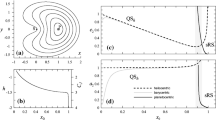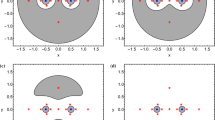Abstract
For the regular polygonal relative equilibria on \(\mathbb S^2\), we show that if all the particles are outside of the equator, then they are orbitally stable in a four-dimensional invariant symplectic manifold. For the stability in full space, if they are close to the north or south pole, then such relative equilibria are spectrally unstable. If they are close to the equator, then if the number of masses is odd, then they are orbitally stable; and if the number of masses is even, then they are spectrally unstable.

Similar content being viewed by others
Notes
Mathematica’s numerical solver works better on algebraic than on transcendental functions. This is one reason for doing the present analysis using \( \mu _n (x) \) instead of \( \lambda _{ p + 1 } \).
References
Arnold, V.I., Kozlov, V.V., Neishtadt, A.I.: Mathematical aspects of classical and celestial mechanics. [Dynamical systems. III], Translated from the Russian original by E. Khukhro, 3rd edition, Encyclopaedia of Mathematical Sciences, 3. Springer, Berlin (2006)
Borisov, A.V., Mamaev, I.S., Kilin, A.A.: Two-body problem on a sphere. Reduction, stochasticity, periodic orbits. Regul. Chaotic Dyn. 9(3), 265–279 (2004)
Borisov, A.V., García-Naranjo, L.C., Mamaev, I.S., Montaldi, J.: Reduction and relative equilibria for the two-body problem on spaces of constant curvature. Celest. Mech. Dyn. Astron. 130(6), 1–36 (2018)
Burnside, W.S., Panton, A.R.: Theory of Equations. Dublin University Press, Dublin (1899)
Deng, Y., Zhu, S.: Odd index of the amended potential implies linear instability, arXiv:2106.06246v1
Diacu, F.: Polygonal homographic orbits of the curved N-body problem. Trans. Am. Math. Soc. 364(5), 2783–2802 (2012)
Diacu, F.: Relative equilibria of the 3-dimensional curved \(n\)-body problem. Mem. Am. Math. Soc. 228, 1071 (2013)
Diacu, F., Pérez-Chavela, E.: Homographic solutions of the curved 3-body problem. J. Differ. Equ. 250(1), 340–366 (2011)
Diacu, F., Zhu, S.: Almost all 3-body relative equilibria are inclined. Discrete Contin. Dyn. Syst. Ser. S 13(4), 1131–1143 (2020)
Diacu, F., Pérez-Chavela, E., Santoprete, M.: The \(n\)-body problem in spaces of constant curvature: part I, relative equilibria. J. Nonlinear Sci. 22(2), 247–266 (2012)
Diacu, F., Martínez, R., Pérez-Chavela, E., Simó, J.C.: On the stability of tetrahedral relative equilibria in the positively curved 4-body problem. Physica D 256(257), 21–35 (2013)
Diacu, F., Sánchez-Cerritos, J.M., Zhu, S.: Stability of fixed points and associated relative equilibria of the 3-body problem on \({\mathbb{S}}^1\) and \({\mathbb{S}}^2\). J. Dyn. Differ. Equ. 30(1), 209–225 (2018a). Modification after publication at arXiv:1603.03339
Diacu, F., Stoica, C., Zhu, S.: Central configurations of the curved \(n\)-body problem. J. Nonlinear Sci. 28(5), 1999–2046 (2018b)
García-Naranjo, L.C., Marrero, J.C., Pérez-Chavela, E., Rodríguez-Olmos, M.: Classification and stability of relative equilibria for the two-body problem in the hyperbolic space of dimension 2. J. Differ. Equ. 260(7), 6375–6404 (2016)
Marsden, J.: Lectures on mechanics. In: London Mathematical Society Lecture Note Series, vol. 174. Cambridge University Press, Cambridge (1992)
Martínez, R., Simó, J.C.: On the stability of the Lagrangian homographic solutions in a curved three-body problem on \({\mathbb{S}}^2\). Discrete Contin. Dyn. Syst. 33(3), 1157–1175 (2013)
Martínez, R., Simó, C.: Relative equilibria of the restricted three-body problem in curved spaces. Celest. Mech. Dyn. Astron. 128(2–3), 221–259 (2017)
Moeckel, R.: Linear stability analysis of some symmetrical classes of relative equilibria. In: Hamiltonian Dynamical Systems (Cincinnati, OH, 1992) (IMA Vol. Math. Appl. vol. 63), pp. 291–317. Springer, New York
Newton, P.K., Ostrovskyi, V.: Energy-momentum stability of icosahedral configurations of point vortices on a sphere. J. Nonlinear Sci. 22, 499–515 (2012)
Pekarsky, S., Marsden, J.E.: Point vortices on a sphere: stability of relative equilibria. J. Math. Phys. 39(11), 5894–5907 (1998)
Pérez-Chavela, E., Sánchez-Cerritos, J.M.: Euler-type relative equilibria and their stability in spaces of constant curvature. Can. J. Math. 70(2), 426–450 (2018)
Pérez-Chavela, E., Sánchez-Cerritos, J.M.: Hyperbolic relative equilibria for the negative curved \(n\)-body problem. Commun. Nonlinear Sci. Numer. Simul. 67, 460–479 (2019)
Roberts, G.E.: Spectral instability of relative equilibria in the planar n-body problem. Nonlinearity 12(4), 757–769 (1999)
Schmah, T., Stoica, C.: Stability for Lagrangian relative equilibria of three-point-mass systems. J. Phys. A 39(46), 14405–14425 (2006)
Simo, J.C., Lewis, D., Marsden, J.E.: Stability of relative equilibria. I. The reduced energy-momentum method. Arch. Ration. Mech. Anal. 115(1), 15–59 (1991)
Stoica, C.: On the \(n\)-body problem on surfaces of revolution. J. Differ. Equ. 264(10), 6191–6225 (2018)
Wolfram Research, Inc. Mathematica, version 11.3 (2018)
Yu, X., Zhu, S.: Regular polygonal equilibrium configurations on \({\mathbb{S} }^1\) and stability of the associated relative equilibria. J. Dyn. Differ. Equ. 33(2), 1071–1086 (2021)
Zhu, S.: Compactness and index of ordinary central configurations for the curved \(N\)-body problem. Regul. Chaotic Dyn. 26(3), 236–257 (2021)
Acknowledgements
This research has been partially supported by Asociación Mexicana de Cultura A.C.. The first two authors were also supported by CONACYT México, project A1S10112. The third author would like to acknowledge NSFC (No. 11801537), China Scholarship Council (CSC NO. 201806345013), and Instituto Tecnológico Autónomo de México for their warm hospitality.
Author information
Authors and Affiliations
Corresponding author
Additional information
Communicated by Paul Newton.
Publisher's Note
Springer Nature remains neutral with regard to jurisdictional claims in published maps and institutional affiliations.
Appendix A. Positivity of \( \lambda _{ p + 1 } \)
Appendix A. Positivity of \( \lambda _{ p + 1 } \)
This “Appendix” offers a numerical study of \( \lambda _{ p+1 } \), supporting the claim that it is positive for all \( n \ge 6 \), n even. Recall that \( \lambda _{ p + 1 } \) is given by (16), with \( n = 2p + 2 \). Thus, \( \lambda _{ p + 1 } (\theta ) \) is a continuous function of \(\theta \) on the open interval \( 0< \theta < \pi / 2 \).
Consider the family of algebraic functions \( \mu _n (x) \), \( x \in (0,1) \), defined by
(That is to say, \( \mu _n \) is obtained from the right-hand side of (16) substituting \( \cos \theta \) with \( \sqrt{x} \) and \( \sin \theta \) with \( \sqrt{1-x} \).) We want to determine the qualitative shape of \( \mu _n (x) \). It turns out that \( \mu _n (x) \) blows-up at the two ends of the interval (0, 1) ; indeed, \( \mu _n (x) \) is \( O(x ^{ -3/2 }) \) near \( x = 0 \) and \( O((1 - x) ^{ -3/2 }) \) near \( x = 1 \). To see this, we start by discussing the limit \( x \rightarrow 0 \) (i.e., \( \theta \rightarrow \pi / 2 \)), which is known to be \(+\infty \) by Proposition 6.
Proposition 14
Near \( x = 0 \), \( \mu _n (x) = x ^{ -3/2 } (\mathfrak {a} _n + \mu _n ^L (x)) \), \( \mathfrak {a}_n > 0 \), for some continuous functions \( \mu _n ^L \) defined on \( [0, \epsilon ) \), \( 0< \epsilon < 1 \), satisfying \( \mu _n ^L (0) = 0 \).
Proof
It suffices to show that \( \lim _{ x \rightarrow 0 } x ^{ 3/2 } \mu _n (x) =\mathfrak {a}_n> 0 \). Recall that
As \( \theta \rightarrow \pi / 2 \), \(\sin ^2d_{nk}, k\ne n\) remains positive except for \(k=\frac{n}{2}\). Thus, all the terms in the two summations on the right-hand-side of (16) remain bounded as \( \theta \rightarrow \pi /2 \) (i.e., \( x \rightarrow 0 \)), except for the one term corresponding to \(k=\frac{n}{2}\). Then, if \( n = 4l \), \( l \in \mathbb {N} \), we have
Similarly, \( n = 4l+2 \), \( l \in \mathbb {N} \), we have \(\lim _{ x \rightarrow 0 } x ^{ 3/2 } \mu _n (x) =\frac{1}{4}.\) Thus, the claim follows. \(\square \)
Proposition 15
Near \( x = 1 \), \( \mu _n (x) = (1-x) ^{ -3/2 } (\mathfrak {b} _n + \mu _n ^R (x)) \), for some continuous function \( \mu _n ^R \) defined on \( (1-\epsilon , 1] \), \( 0< \epsilon < 1 \), with \( \mu _n ^R (0) = 0 \). Moreover, \( \mathfrak {b} _4 < 0 \) and \( \mathfrak {b} _n > 0 \) for all \( n > 4 \), \( n \in 2 \mathbb {N} \).
In lieu of a proof for Proposition 15, we offer the numerical evidence presented in Table 1, where we compute \( \mathfrak {b} _n = \lim _{ x \rightarrow 1^{-} } (1-x) ^{ 3/2 } \mu _n (x) \) for \( n = 4, 8, \ldots , 32 \). Note that \( \mathfrak {b} _4 \) is the only negative number in the column.
It follows from Propositions 14 and 15, and the intermediate value theorem, that there is at least one root of \( \mu _4 (x) \) on the interval (0, 1) . Using Mathematica’s numerical solverFootnote 1 (Wolfram Research, Inc. 2018), it is verified that there is exactly one root \( x _4 ^*\in (0,1) \), \( x _4 ^*\approx 0.70787\), (or \(\theta \approx 0.571\), see Section 5.4). Thus, \( \mu _4 (x) > 0 \) for \( x \in (0, x _4 ^*) \) and \( \mu _4 (x) < 0 \) for \( x \in (x _4 ^*, 1) \). On the other hand,
Proposition 16
For \( n > 4 \), \( n \in 2 \mathbb {N} \), \( \mu _n (x) \) is strictly positive on the interval (0, 1) .
Again, in lieu of a proof, we offer the numerical evidence provided by Table 1. Using Mathematica’s numerical solver, we computed the critical points \( x _n \) of \( \mu _n (x) \) and verified that there is exactly one such critical point on the interval (0, 1) for each \( n = 6, 8, \ldots , 32 \). In the last column, we compute the corresponding critical values, all of them strictly positive. Propositions 14 and 15 then imply that such critical values are absolute minima on the interval (0, 1) . Note that these minima appear to be increasing as \( n \rightarrow \infty \); the trend is shown in Fig. 2a for \( n = 6, 8, \ldots , 64 \). Figure 2b–d illustrate the graphs of \( \mu _n (x) \) for \( n = 4, 6, 12 \).
Rights and permissions
Springer Nature or its licensor holds exclusive rights to this article under a publishing agreement with the author(s) or other rightsholder(s); author self-archiving of the accepted manuscript version of this article is solely governed by the terms of such publishing agreement and applicable law.
About this article
Cite this article
Hernández-Garduño, A., Pérez-Chavela, E. & Zhu, S. Stability of Regular Polygonal Relative Equilibria on \(\mathbf{}\mathbb S^2\). J Nonlinear Sci 32, 73 (2022). https://doi.org/10.1007/s00332-022-09824-7
Received:
Accepted:
Published:
DOI: https://doi.org/10.1007/s00332-022-09824-7
Keywords
- Curved n-body problem
- Regular polygonal relative equilibria
- Sub-critical pitch fork bifurcation
- Reduced energy-momentum method
- Orbital stability





